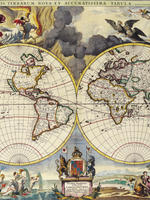
Mapping the Government

The National Geographic periodically publishes updated maps of the contours of the U.S. but there is no institution that takes on a similar task, updating the contours of the ever-changing federal government. However the Administrative Conference has recently updated a long-forgotten “map” last prepared by the Congressional Research Service in 1980. The authors are David Lewis and Jennifer Selin, of Vanderbilt University.
The new Sourcebook of United States Executive Agencies according to its authors, “describes the evolution of the current executive establishment, looks backward to understand what now exists, and analyzes trends to see what may be coming.” So it isn’t just a simple set of organization charts of various agencies, along with key missions and positions. Those exist in the annually-prepared United States Government Manual and the quadrennially-prepared Plum Book.
How Many Government Agencies Are There?
You would think there would be a simple answer. However, the authors note that “there is no authoritative list of government agencies” and that “many federal entities do not neatly reside in the executive branch.” They observe that the Government Manual lists 96 independent executive units and 220 components of the executive departments, while the website USA.gov lists 137 independent executive agencies with 268 components. Other sources list different numbers, as well. So the first section of the report addresses the question “What is a Federal Agency?” and comes to no real conclusion because “Congress defines what an ‘agency’ is in relation to particular laws rather than provide one overarching definition.” For example, is the Federal Agricultural Mortgage Corporation a government agency? It is governed by a board in which two-thirds of the members are selected by private shareholders, not the President. What about venture capital funds, such as In-Q-Tel?
Not even the courts have offered a definitive answer, so the authors developed their own definition so they could provide a count, and bound their study. They define an agency as “a federal executive instrumentality headed by one or more political appointed nominated by the President and confirmed by the Senate.”
Characteristics of Federal Agencies
The heart of the Sourcebook isn’t a mere count of agencies or how many work for the government (a more problematic number, if you can’t count the number of agencies in the first place, but the authors say it stands around 2.13 million or 2.85 million civilians, depending on how you count them). The value is in its exploration of the various characteristics of agencies, which are detailed in tables that provide answers to questions such as:
- How many agencies are inside the Executive Office of the President?
- How many appointees are in each of the Executive Departments?
- How many Independent Agencies are there?
- Which bureaus have chiefs appointed with fixed terms?
- What are the different agency-specific personnel systems?
- Which agencies are excluded from OMB review of their budgets, rulemaking, and legislative proposals?
- Which agencies have statutes that provide monies other than through appropriations?
- Which agencies have adjudicatory authority?
- Which Senate committees have jurisdiction over the confirmation of different agency nominees?
- A list of all agencies (based on the definition of the authors) and their acronyms (of course the list begins with the Administrative Conference of the U.S., which sponsored the study!)
The Sourcebook ends with some insights about the creation and design of federal agencies, which could be useful context in discussions to create new agencies, or more importantly, reorganization efforts, which could be on the agenda in coming years.
Graphic Credit: Looking Through the Lens Blog



